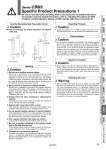
es20-223-cm2ü@ü@ü@94 / 122
10ĢbīŃé╔BOOKé╠āyü[āWé╔ł┌ō«éĄé▄éĘ
W W Use the Recommended Pneumatic Circuit Handling Operating Pressure Exhaust Speed Relation to Cushion Releasing the Lock Caution Caution Caution Caution Warning Caution P This is necessary for proper operation and release of the lock. Head end lock Rod end lock 1. Supply air pressure of 0.15 MPa or higher to the port on the lock mechanism side, as it is necessary for releasing the lock. 1. The lock will be engaged automatically if the pressure applied to the port on the lock mechanism side falls to 0.05 MPa or less. In cases where the piping on the lock mechanism side is long and thin, or the speed controller is separated at some distance from the cylinder port, the exhaust speed will be reduced. Take note that some time may be required for the lock to engage. In addition, clogging of a silencer mounted on the solenoid valve exhaust port can produce the same effect. 1. When cushion valve at lock mechanism side is fully opened or closed, piston rod may not be reached at stroke end. Thus, lock is not established. And when locking is done at cushion valve fully closed, adjust cushion valve since lock may not be released. 1. Before releasing the lock, be sure to supply air to the side without a lock mechanism, so that there is no load applied to the lock mechanism when it is released. (Refer to the recommended pneumatic circuits.) If the lock is released when the port on the other side is in an exhaust state, and with a load applied to the lock unit, the lock unit may be subjected to an excessive force and be damaged. Furthermore, sudden movement of the piston rod is very dangerous. Series CBM2 Specific Product Precautions 1 Be sure to read this before handling. Refer to the back cover for Safety Instructions. For Actuator and Auto Switch Precautions, refer to ügHandling Precautions for SMC Productsüh and the Operation Manual on SMC website, http://www.smcworld.com 1. Do not use 3 position solenoid valves. Avoid use in combination with 3 position solenoid valves (especially closed center metal seal types). If pressure is trapped in the port on the lock mechanism side, the cylinder cannot be locked. Furthermore, even after being locked, the lock may be released after some time, due to air leaking from the solenoid valve and entering the cylinder. 2. Back pressure is required to release end lock. Be sure air is supplied to the side of the cylinder without a lock mechanism (side of the piston rod without lock for double end lock), before starting up, as in the above figures. Otherwise, the lock may not be released. (Refer to ügReleasing the Locküh.) 3. Release the lock when mounting or adjusting the cylinder. If mounting or other work is performed when the cylinder is locked, the lock unit may be damaged. 4. Operate with a load ratio of 50% or less. If the load ratio exceeds 50%, this may cause problems such as failure of the lock to release, or damage to the lock unit. 5. Do not operate multiple cylinders in synchronization. Avoid applications in which two or more cylinders with end lock are synchronized to move one workpiece, as one of the cylinder locks may not be able to release when required. 6. Use a speed controller with meter-out control. Lock cannot be released occasionally by meter-in control. 7. Be sure to operate completely to the cylinder stroke end on the side with the lock. If the cylinder piston does not reach the end of the stroke, locking might not work or locking might not be released. 8. The base oil of grease may seep out. The base oil of grease in the cylinder may seep out of the tube, cover, or crimped part depending on the operating conditions (ambient temperature 40üŗC or more, pressurized condition, low frequency operation). 92 CM2Q CBM2 CM2«P CM2RK CM2R CM2K CM2KW CM2K CM2 CM2W CM2 Low Friction With End Lock Centralized Piping Direct Mount, Non-rotating Rod Direct Mount Non-rotating Rod Standard Double Acting, Single Rod Double Acting, Single Rod Double Acting, Single Rod Double Acting, Single Rod Single Acting, Spring Return/Extend Double Acting, Double Rod Double Acting, Single Rod Single Acting, Spring Return/Extend Double Acting, Double Rod Double Acting, Single Rod Made to Order Auto Switch